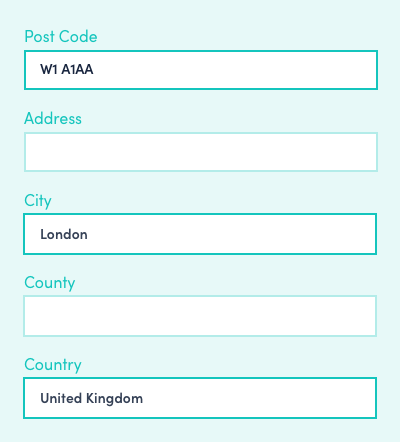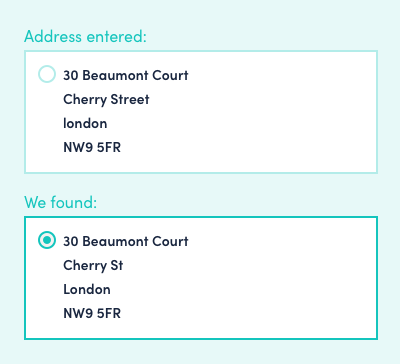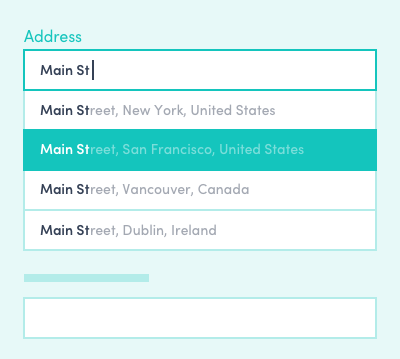Glossary
Address Validation: The Complete Guide
What is Address Validation?
Address validation (or as it's sometimes called, address verification) is a way used to capture and clean up your address data. An address can be validated in one of two ways: by capturing an address at the point of entry by the end user or by cleansing, parsing, matching formatting, transliterating and enhancing data in a database against reference data.
Why is Address Validation Important? Core Benefits
One major difficulty all organisations tend to face is the rapid pace at which transactions take place in a digital world.
Address validation is a way around all of that, and grants tons of efficiency-boosting benefits to organizations. Examples include the following:
- Streamlining customers' journies, allowing them to check out by auto-completing form fields
- Validating an address for accuracy, in real-time, during that same checkout process
- Geocoding and reverse-geocoding addresses with latitude and longitude data
- Effortlessly ensuring compliance with laws around identity verification
- Mapping the distance between two points
- Establishing early communication shipping carriers, to get ahead of potential shipping delays
- Enriching your customer records with accurate information
Address validation is critical for organizations operating with global customer bases. That’s because those businesses will usually use different address databases by region. For instance, the United States Postal Service (USPS), UPS, FedEx, Canada Post, and a range of national postal carriers maintain their own developer tools and address.
That means those folks need a simplified way to communicate with, potentially, hundreds of shipping carriers in all their countries of operation.
What are the most common types of address validation?
The most frequent types of address validation you'll include drop-down verification, partial verification, post-entry verification and type-ahead verification. These tend to operate quite differently. Below, we've summarised each so that you know what you'll need to when deciding which type to choose for your website.
Drop-down address validation is where the state, county and country fields can be found using a drop-down:

With partial validation, a postal code entry populates the city and state or county, while manual entry of the rest of the address is required.

Post-entry validation is where users will need to manually put their own address in the field, then a pop-up shows possible alternatives, with the user required to choose the correct one.

Type-ahead validation (which is the kind we offer here at Loqate!) is where the user starts typing their address into a single field, and as they type, increasingly accurate suggestions are offered. Clicking on a suggestion returns the full address.

What is inline address validation?
Inline verification is a way of checking the validity of data input and providing feedback before the user even reaches the point of submission on your customer form. It significantly improves the usability and UX of forms, and stops your customers from abandoning so often by giving them a quicker way to pop their details in. Loqate’s address validation software has to been shown to reduce address entry time by up to 78% and cuts back data entry errors at point of capture by more than 20%, all improving the end user experience.
What is single line address finding?
The single line address lookup layout refines and simplifies your address forms down to just one field. Only requiring your customers to begin typing on a single line is quicker and simpler than traditional address forms, and also results in said forms occupying less space. Single line address lookup is a more efficient and user-friendly approach to implementing an address look-up, and our UX research shows that users are 2x as likely to find an address and complete using single line versus multi-line.
How does type-ahead address validation differ from traditional postal code lookup?
Traditional postcode lookup |
Type-ahead |
| Lookup UK addresses | Look up UK and international addresses |
| Enter the postcode to search | Enter any part of an address to begin searching |
| Searches from a whole postcode | Allows you to miss out parts of the address or postcode and returns matches, you don’t need to know the postcode |
| Press a single button to display results | Results are displayed as soon as you start searching |
| No filtering options to narrow results | Narrow results further as you type more details of the address |
| Postcode needs to be typed without errors | Type-ahead understands common misspellings |
| Results ordered alpha-numerically | Option to order results by nearest to the user or your operational location |
| Shows all matching addresses for the postcode | Customisable to show only business or residential addresses, not yet built (NYB) premises and multi-residence data (NOTE: this data is not included as standard) |
| You can auto-complete the address form with the selected address | Selected address auto-completes form - you can reduce your address form to a single line |
| Easy to integrate/install | Easy to integrate/install |
| Address data from Royal Mail's PAF® database | Includes address data from Royal Mail's PAF®, USPS and Canada Post |
| As seen on: Oxfam, flybe, and more | As seen on: ASOS, Graze.com, Superdry and more |
Guide to Address Validication Methods
Behind the scenes of your address validation program, various technical processes are rumbling on. Understanding them will help you identify use cases for address validation in your business.
Fuzzy Matching
Even if you have a typo in your address query, you can still get relevant results. An address validation API can detect misspelled or missing information such as spaces and letters, and then use these to produce more precise results.
This technology is particularly useful for mobile digital environments that are prone to typos due to small screen sizes. Fuzzy matching is valuable for increasing data quality.
Learn more: What is fuzzy matching?
Geocoding & Reverse Geocoding
Geocoding is the practice of assigning latitude and longitude coordinates to a geographic location. Reverse geocoding is the opposite process to that - that is, assigning a location to a geographic coordinate system.
This method is used for visualizing data, augmenting location datasets, and identifying store networks, warehouse locations, events, and other relevant information. Geocoding helps with optimizing deliveries, anticipating real-world risks, and providing insight about locations.
Address Standardization
The process of standardizing addresses is important for ensuring that the various systems at work can communicate with each other effectively. Every postal system requires its own official format. An API can break unstructured address data into its component parts and automatically reformat addresses into the correct output structure.
Address Validation in North America
There are a number of address validation services and API solutions available to meet different business requirements and needs. Here are some key points it's worth taking the time to consider when selecting the right validation technology for your business:
- Frequency of data updates
- Processes for safeguarding company data
- Uptime standards
- Ability to address typos
- Data sources and their integrity
- Integration and deployment time
- Back-end address validation to clean up, parse, and standardize data in integrated software
- Additional services
- Additional datasets
- Customer support options
As organizations evolve - and especially when they scale globally - their address validation needs tend to become more complex to boot. In these situations, paid services are available for APIs that support the following use cases:
- Integrations with multiple postal carriers
- Third-party application development
- Correcting customer-generated errors
- Building a rich database
- Maintaining CRM hygiene
Successful address validation strategies can support and elevate your higher level business goals such as error reduction, database enrichment, and delivery speed.
Loqate helps businesses around the world validate customer addresses by combining our global datasets with best in class technology. Our easy to integrate API helps our customers verify customer data at the point of capture. Find out more about how Loqate address verification solutions can help your business.